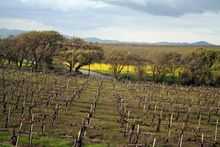Livermore Valley AVA
| Wine region | |
 Vineyard in Livermore | |
| Type | American Viticultural Area |
|---|---|
| Year established | 1982, amended 2006[1] |
| Country | USA |
| Part of | California, Central Coast AVA, San Francisco Bay AVA |
| Total area | 96,000 acres (38,850 ha)[2] |
| Grapes produced | Barbera, Cabernet Franc, Cabernet Sauvignon, Chardonnay, Chenin blanc, Cinsault, Colombard, Counoise, Gewurztraminer, Grenache, Malbec, Merlot, Mourvedre, Muscat Canelli, Petit Verdot, Petite Sirah, Pinot blanc, Pinot gris, Pinot noir, Roussanne, Sangiovese, Sauvignon blanc, Semillon, Souzao, Syrah, Tempranillo, Touriga Francesa, Touriga Nacional, Viognier, Zinfandel[3] |
The Livermore Valley AVA is an American Viticultural Area in Alameda County, California, surrounding the city of Livermore in the Tri-Valley region. Both the AVA and the city are named after Robert Livermore, a landowner whose holdings encompassed the valley. The groundwater basin underlying the valley is the Livermore Basin, the largest sub-unit of which is the Mocho Subbasin. The Livermore Basin is one of five aquifers in the San Francisco Bay Area that supply most of the metropolitan Bay Area population.[4] The entire Livermore Basin aquifer faces a concern over elevated total dissolved solids by the year 2020 due to an expanding human population leading to higher rates of return water flows to the aquifer containing certain salts.[5]
Wine production
Wine has been cultivated in Livermore since the 19th century, with the Cresta Blanca Winery (founded 1882) being one of the earliest, and well-respected, with its first vintage (1884) winning Grand Prix at the 1889 Paris Exposition, becoming the first California wine to win a competition in France. Vineyards were shuttered during Prohibition, however, with the exception of two wineries, Concannon and Wente.
In the early 1960s, Livermore had as much area under vine as Napa Valley did at that time. However, it remained relatively unknown, while Napa rose to worldwide prominence. Wente Vineyards has long been the largest producer in the Livermore Valley, making around 700,000 cases of wine annually with wholesale, tasting room and export sales. It was first established in the valley in 1883 and is now the oldest family owned continuously operated winery in the United States. The other large producer, Concannon Vineyard, was established at a similar date and is now owned by the Wine Group, Their wines, along with an Irish whiskey, are in distribution along with a tasting room for direct sales. The rest are mostly new and considerably smaller. These wineries include Nottingham Cellars, Murrieta's Well, The Winemakers' Studio, Steven Kent Winery & La Rochelle, Wood Family Vineyards, McGrail Vineyards, Cuda Ridge Winery, Retzlaff Winery, Fenestra Winery, Occasio Winery, Stony Ridge/Crooked Vine Cellars, Longevity Wines, Rodrigue Molyneux Winery, 3 Steves Winery, Big White House/John Evan, Charles R Vineyards, Garre' Winery, Ehrenberg Cellars, The Singing Winemaker, Chouinard Vineyards, Elliston Vineyards, Las Positas Vineyards, Dante Robere Vineyards, Les Chenes Estate, Ruby Hill Winery, Rubino Estates, Bodegas Aguirre, Mitchell Katz Winery, Auburn James Winery and Thomas Coyne Winery, Page Mill Winery.
Livermore possesses a predominately gravel based soil and lies on a unique east-west orientation, unlike many other winegrowing valleys. Due to a reliable onshore afternoon/evening breeze off of the San Francisco Bay a wide fluctuation in temperature between sites and a large diurnal temperature swing occur. Livermore Valley is considered a Winkler Region III grape growing zone with temperatures comparable to northern Napa Valley appellations such as St. Helena or Calistoga.
The relatively obscure Petite Sirah grape produced Livermore's best historically known red wine, although the climate also makes for interesting dessert wines as well as excellent Cabernet Sauvignon, Merlot and Rhone varieties. The original plantings of Sémillon and Sauvignon blanc were cuttings taken from Château d'Yquem, and those grapes tend to produce fine wine in the Livermore area. There is also a move afoot among the wineries in Livermore to specialize in Chardonnay, Sauvignon Blanc, Merlot, Cabernet Sauvignon, and some other mostly Bordeaux varieties. Wine made from grapes grown in the Livermore Valley is eligible for the Livermore Valley AVA, San Francisco Bay AVA, and Central Coast AVA appellation of origin designations.
Wineries and vineyards
Photo gallery
-

Cedar Mountain Winery
-

Rios-Lovell Estate Winery
-

Steven Kent Winery
-

Driveway to Retzlaff Vineyards
-

Cuda Ridge Wines
See also
References
- ↑ Code of Federal Regulations. "§ 9.46 Livermore Valley." Title 27: Alcohol, Tobacco and Firearms; Part 9 — American Viticultural Areas; Subpart C — Approved American Viticultural Areas. Retrieved January 24, 2008.
- ↑ Wine Institute (2008). "American Viticultural Areas by State". Retrieved January 24, 2008.
- ↑ Appellation America (2007). "Livermore Valley (AVA): Appellation Description". Retrieved January 24, 2008.
- ↑ San Francisco Bay Area Regional Water Quality Control Board (2004). "San Francisco Bay Area Regional Water Quality Control Board Integrated Management Plan (2004)". Retrieved January 24, 2008.
- ↑ Bonnie, Thomas L. (2000) "What are the projected impacts of injecting reclaimed, reverse osmosis water into the Livermore-Amador Groundwater Basin?". Retrieved January 24, 2008.
External links
Coordinates: 37°39′N 121°46′W / 37.65°N 121.76°W
| ||||||||||||||||||||||